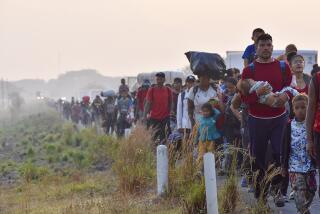New wave of immigrants — a new target too?

It’s official! A new study by the Pew Research Center proves the old trope true: Asians are the new Jews. All those essentially positive stereotypes you’ve heard about — the hard work and the Tiger Moms — have made Asian Americans the highest-income, best-educated and fastest-growing racial group in the United States. Not only that, in the last few years, Asians have overtaken Latinos as the largest group of new immigrants to the U.S.
This is all good news — both for Asian Americans and the United States — but the Jewish comparison has a dark side. Once the cheering over this study, titled “The Rise of Asian America,” has subsided, we might remember it as the dawn of a new era of anti-Asian bias.
Americans tend to view race and ethnic relations as a linear progression. The triumphant narrative of the civil rights movement has us convinced that things get better over time: Economic status rises as prejudice decreases, and vice versa. We also like to tell ourselves that bias is always targeted downward, at the weakest and the most vulnerable in society.
But neither assumption is true, and the sooner we recognize that, the better position we’ll be in to manage race relations in a rapidly changing America.
We should start by getting rid of the canard that modern anti-Semitism is primarily a form of religious bigotry. Christopher Hitchens was one of the few contemporary figures who openly argued what I have long suspected: distrust or disdain of Jews can sometimes be motivated by envy and resentment of an identifiably separate group that’s significantly wealthier than the population at large.
A decade or so ago, a prominent conservative political writer went so far as to tell me off the record of his suspicion that a large portion of Jewish philanthropy is motivated by a desire to defuse envy over the income disparity between the Jewish and Gentile populations.
All of this suggests that invidious comparisons between groups are alive, that they’re stoked by economics and that, though not particularly venomous in the U.S. right now, they have the potential to become dangerous under the wrong circumstances.
Chinese merchants throughout Asia have known this for a long time. In Southeast Asia, they make up something of a creditor class that has, from time to time, faced persecution and political attack. Nowhere is this more true than in Indonesia, where the Chinese are known as “the middle race.” In 1959, the Indonesian government implemented anti-Chinese legislation that forced Chinese merchants to abandon their businesses. In 1973, a riot in West Java led to the looting and destruction of more than 1,500 Chinese Indonesian-owned shops and houses. In 1998, as Indonesia’s economy imploded amid the broader Asian financial crisis, rioting with a strong anti-Chinese element took the lives of at least 1,000 people, costing $250 million in damages.
I’m not predicting that any of this will happen to Chinese Americans, who make up nearly a quarter of Asians in the U.S. But you’d be naive not to see the flip side of last week’s Pew study, which states that the median household income of Asian Americans is 33% higher than that of the general public.
Here in California, we’ve long heard grumbling about the number of Asians gaining admittance to the public university system. UC Irvine, whose undergraduate student body is 49% Asian, has been nicknamed the “University of Chinese and Indians.” UCLA, which had a 2011 freshman class that was 41% Asian American, has been dubbed “University of Caucasians Lost Among Asians.”
The “rise of Asian Americans” coincides withChina’semergence as a global power. As competition with China heats up, Asian Americans may feel the brunt of any anti-China sentiment. And history tells us that bigots don’t really care about your actual background as long as you look the part. Case in point? Last week saw the 30th anniversary of the killing of Vincent Chin, a Chinese American in Michigan who died after he was beaten by two out-of-work autoworkers who blamed him for competition from the Japanese automobile industry.
It’s tempting to ascribe the success of Asian Americans to our beloved rags-to-riches narrative, and to believe that they have achieved the old-fashioned American dream. But that’s not quite true, and that too could feed resentment.
Six in 10 adult immigrants from Asia arrive in the United States with at least a bachelor’s degree. So while activists have spent the last generation demanding an end to low-skilled immigration, we shouldn’t be surprised if we start hearing calls for the end of highly skilled immigration from Asia. More than anything else, race relations American-style have always been about sharp elbows and hunger for a piece of the pie.
grodriguez@latimescolumnists.com
More to Read
Start your day right
Sign up for Essential California for news, features and recommendations from the L.A. Times and beyond in your inbox six days a week.
You may occasionally receive promotional content from the Los Angeles Times.






